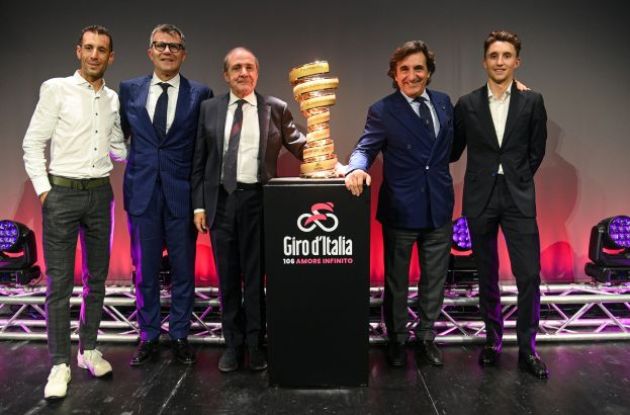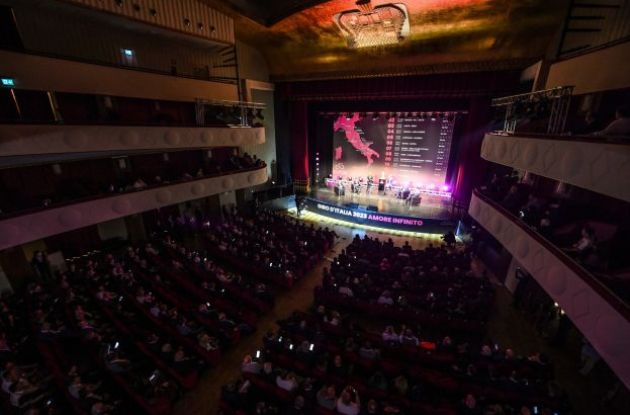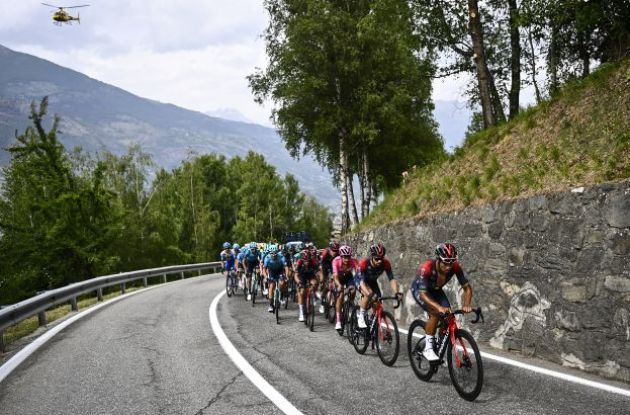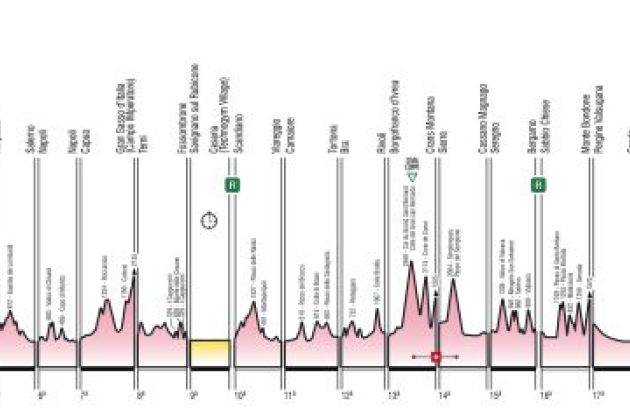2023 Giro d’Italia Route Revealed
The route of Giro d’Italia 2023 has been revealed at a grand event in Milan’s famous Teatro Lirico Giorgio Gaber. Next year’s Giro d’Italia offers the professional cycling peloton a challenging 3449-kilometer route in mainland Italy and Switzerland. The route features no less than three individual time trial stages (stages 1, 9, and 20), seven mountain stages concluding on mountain tops, four hilly stages, and eight stages that appeal to sprinters and encourage them to remain in the race all the way to its finish in Rome on May 28.
As previously announced, next year’s Giro d’Italia will commence in the Abruzzo region situated next to the Adriatic Sea in southern Italy. The race starts on Saturday, May 6 and the first three stages will take place in Abruzzo, before leaving Abruzzo only to return to Abruzzo for the mountaintop conclusion of stage 7. Stage 1 will be a 18.4-kilometer individual time trial along the Costa dei Trabocchi cycle path that traces the disused scenic Adriatic railway line. Visit our article about the Giro start in Abruzzo to learn more about the stages, the region and its historic role in cinema.
Stage 13 will take the Giro peloton into Switzerland where the riders will contest the highest point of the 2023 Giro – the Cima Coppi – on Col du Grand Saint-Bernard (2469 meters) before the 208-kilometer stage concludes uphill on the legendary Crans Montana climb.
Next year’s Giro d’Italia will conclude in Rome for the fifth time in history – this time at the Imperial Forums.
The Giro d’Italia route presentation event was attended by defending Giro d’Italia champion Jai Hindley (Team Bora-Hansgrohe), points classification winner Arnaud Demare (Groupama-FDJ), Koen Bouwman, who won the mountains classification for Team Jumbo-Visma, Alberto Contador, and recently retired Vincenzo Nibali. Giro d’Italia race director Mauro Vegni also appeared on stage together with RCS Mediagroup president Urbano Cairo and RCS Sport CEO Paolo Bellino.
After watching the route being revealed in Milan, climbing expert Hindley appeared politely displeased with the route design for next year’s Giro in which he currently considers taking part to try to defend his Giro champion title.
“The whole route is quite interesting. I think stage seven with its finish atop Campo Imperatore will be very important. I won there in 2017 at the Giro Under 23 (Giro Ciclistico d'Italia). I have yet to plan my 2023 season, but I hope to be at the start of the Giro next year.”
Hindley fears the three individual time trials of next year’s Giro will inhibit his chances of overall success and told Roadcycling.com he will await the presentation of the 2023 Tour de France route before he decides if he will aim for his first Tour de France title or ride the Giro as defending champion of a grand tour for the first time in his career.
By including no less than 70 kilometers time trial in next year’s Giro route, race organizers are hoping the route will appeal to Vuelta a Espana champion and World Champion Remco Evenepoel (Team Soudal-QuickStep). Evenepoel claims he has already chosen what Grand Tours to participate in next year. However, he says he has decided not to announce his decision before January.
Detailed 2023 Giro d’Italia Route Description
Week One
Starting from Vasto, the 2023 Giro d’Italia route travels south to reach Melfi in a stage divided into two different terrain parts. The first part is completely flat, all the way to the entrance to the Basilicata. Here, the Vulture mountains start. Riders will cross the Monte Vulture massif approach the Monticchio Lakes before descending to Rionero and Rapolla after which they will compete on the final descent to Melfi.
The following day is a stage in the Apennines, with a series of climbs totalling 3500 elevation meters. From Venosa and leading to Lago Laceno, stage 4 offers the first uphill finish of the 2023 Giro d’Italia.
Stages 5 and 6 on Wednesday, May 10 and Thursday, May 11 will provide two opportunities for the fastest sprinters in the Giro peloton. The two stages take the riders from Atripalda to Salerno and Napoli to Napoli, although this is not entirely flat, so some sprinters may struggle to keep up.
The second uphill finish of the Giro d’Italia, and the first above 2000 meters, is in Campo Imperatore on the Gran Sasso d’Italia (2135 meters). Starting from Capua, the peloton will face the climbs of Roccaraso and Piano delle Cinque Miglia before a very long descent to the foot of the Gran Sasso. The ascent to Campo Imperatore is a virtually endless climb of almost 45 kilometers.
Spectators can look forward to an exciting Saturday as May 13 has been chosen by the Giro organizers for an undulating stage from Terni to Fossombrone. It features the Muri (“walls”) of the Marche, and includes 2,500 meters of climbing, all within the final 60 kilometers. Riders will be challenged to the ascents of the Cappuccini (about 3 kilometers, with gradients up to 19%) and Monte delle Cesane (approximately 7 kilometers, with gradients up to 18 percent). Following Montefelcino, they will return to the Cappuccini ascent, situated 5 kilometers from the finish line.
The following Sunday will present the already exhausted riders with a 33.6 kilometers completely flat time trial, starting from Savignano al Rubicone and finishing in Technogym Village of Cesena.
Week Two
After a challenging first week, the first rest day of the Giro d’Italia 2023 is scheduled for Monday 15. The two following stages, on Tuesday, May 16 (Scandiano to Viareggio) and Wednesday, May 17 (Camaiore - Tortona) will appeal to the well-rested sprinters.
Stage 12 takes place on Thursday 18 May and a 179-kilometer ride from Bra to Rivoli has been designed by race organizers on a varied and hilly route that will appeal to breakaway hopefuls. After the first hilly section, the route continues for about 30 kilometers before entering 40 kilometers false-flat, then crossing the Po Valley and passing the finish line. Riders will then tackle the challenging climb of Colle Braida and pass the Sacra di San Michele, followed by the final 28 kilometers downhill towards and into Rivoli.
The following day the Giro peloton departs Italy for a trip into Switzerland on an alpine expedition from Borgofranco d’Ivrea to Crans Montana. The stage 13 route will see the riders climb the Colle del Gran San Bernardo (2469 meters), which is also the Cima Coppi (highest point) of the 2023 Giro and totals 34 kilometers of climbing, then conquers the Croix de Coeur (15 kilometers and 1350 meters in elevation). After a second descent, totaling 22 km, there is a 13-kilometer final undulating ascent up the Crans Montana from a previously unused side.
When the Giro enters stage 14, the chosen terrain is finally of great appeal to sprinters who hope to be rewarded for their struggles in the previous mountain stages. Stage 14 will take the riders from Sierre to Cassano Magnago before the “mountain in the city” stage 15 from Seregno to Bergamo on Sunday, May 21. Although characterized by fairly simple climbs, they’ll offer opportunities for any type of attack. The stage features the Valcava and the Selvino, before descending on Bracca and Sedrina and returning to Bergamo to cross the finish line (strappo della Boccola). Riders will then tackle the Roncola from the Barlino side, and descend back into Bergamo, eventually arriving in the city.
Week Three
No sooner than after the second rest day, the second mountain stage of the Giro d’Italia 2023 awaits the riders. Most of the Sabbio Chiese to Monte Bondone stage takes place all relatively low altitudes yet accumulates more than 5000 meters of challenging climbing. The route is varied with several very hard climbs and others of more gentle gradient percentages. The first section, along the western coast of Garda, reaches Trentino in Riva del Garda, then the Passo di Santa Barbara (approximately 10 percent gradient), eventually reaching the Passo di Bordala. A fast descent to Rovereto enters Vallarsa where riders will turn towards the Folgaria plateau and pass through Serrada. The challenging descent to the Adige valley in Calliano leads to a climb to Monte Bondone from the Aldeno side (gradients of up to 15 percent). Wednesday, Stage 17 on May 24 offers another completely flat stage from Pergine Valsugana to Caorle.
Stage 18 is a short, yet intense mountain stage from Oderzo to the Val di Zoldo and features 3,700 meters of vertical elevation. Riders will take on the Cansiglio climb (Passo la Crosetta) and enter the Alpago area and Piave valley. Following Longarone, the route touches Pieve di Cadore and climbs the Forcella Cibiana. After Forno, with the Coi climb (4 km over 10 percent, peaking at 19 Percent), only five kilometers remain to the finish line.
Friday, May 26 is the dolomitic stage of the 2023 Corsa Rosa, from Longarone to the Tre Cime di Lavaredo (182 kilometers and 5,400 height meters). After the riders approach the real challenges of the stage through the Agordino, a series of climbs start in Arabba, including the Campolongo Pass and the Valparola Pass, before the "Scala Santa" of the Dolomite climbs, with Passo Giau (Selva di Cadore side about 10% average gradient) and the Passo Tre Croci and Tre Cime di Lavaredo with its slopes of up to 18 percent. For 2023, the 60th anniversary of the Vajont tragedy will be commemorated. In 1963 a landslide above the Vajont Dam formed a wave, which flooded and destroyed several villages in the valley area and caused the death of approximately 2000 people.
After the Dolomitic stage, a very demanding individual time trial from Tarvisio to Monte Lussari awaits with its approximately 1050 meters in vertical elevation. The first 10 kilometers is on a flat, light descent along the Alpe Adria cycle path, before reaching the Saisera river. The route features around 8 kilometers of paved concrete leading to the Sanctuary. This uphill stretch of 7.5 kilometers has a 12% average gradient. The first 4.8 kilometers reach no less than 15% (comparable to the central stretch of the Monte Zoncolan climb). A wavy final section with a short climb (up to 22%) at the entrance to the town is followed by a short descent, and then a final climb to the finish line where a winner will finally be found.
Stage 21 is a parade stage from Rome to Rome during which riders will toast to their remarkable and memorable performances in the Giro and celebrate with Franciacorta, prosecco, and Asti in their glasses before the grand sprint finale towards the finish line in Rome.
The average length of the stages of Giro d’Italia 2023 is 164.2 kilometers.













